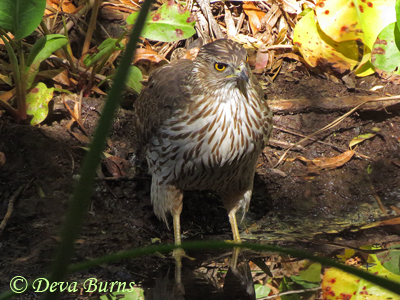
Friend: “Whoa, that looks like a hawk.”
Deva: “I think it’s a Cooper’s Hawk.”
Friend: “No, that’s not a Cooper’s Hawk.”
Deva: “I’ll snap a picture and show it to Jim.”
Deva is a casual birder, her friend a non-birder. There is only one thing in the above conversation that rings true. It’s not that her non-birder friend would have any reason to know one raptor from another, but it’s also certainly not the implication that I might be considered a final authority on accipiter identification.
No, it’s the word “think” in Deva’s first reaction. Without having regularly spent time at a hawk watch during migration, which I have not and neither has she, anyone confidently identifying an accipiter to species, especially a perched or bathing one, is just blowing smoke. Separating Sharp-shinned from Cooper’s Hawk without repeated observations and comparisons of the two in flight is one of the toughest calls in the birder’s world. Here’s why:
1--The plumages of Sharpies and Coops are virtually the same.
2--This is true for immatures of each species as well as adults.
3--The obvious difference in size between males and females in each species is of no help in separating the species unless maybe you had all four lined up side by side.
4--The differences in proportion between immatures and adults (immatures have shorter, broader wings and longer tails) are the same in each species.
5--Because Sharpies are one of the most secretive and seldom seen raptors during breeding season, because Cooper’s are the more common of the two in the West (but not in the East), and because Coops on average are smaller in the West than Coops in the East (and thus closer in size to Sharpies), birders may mistakenly assume any accipiter seen in Arizona, even in winter, is a Cooper’s.
In a paragraph from Hawks in Flight Pete Dunne describes the “generic” accipiter—a round-winged raptor that uses thermals to gain altitude, it appears brown above, white with streaking below, has a long banded tail and white undertail coverts. The very best way to begin separating these look-alike hawks is to watch for generic accipiters overhead and study the mannerisms and nuances of their flight, and you don’t necessarily need binoculars to familiarize yourself with the differences you’re trying to observe. Here are five good keys to accipiters in flight. Remember, these apply to birds seen overhead, not to those seen chasing prey:
1—Sharpies typically look like they’re on a mission, in a hurry to get somewhere.
Coops typically look languid, lazy, and in no hurry at all.
2—Sharpies fly with rapid wingbeats, too rapid to actually count.
Coops fly with much slower wingbeats (because they are larger birds).
3—Sharpies’ wingbeats look snappy, with the “hands” doing the work.
Coops’ wingbeats look stiff, the inner part of the wing and the “shoulders” doing the work.
4—Sharpies in flight appear buoyant, light, and airy.
Coops in flight appear steady and even.
5—Sharpies’ flight looks labored and ineffectual.
Coops’ flight looks sturdy and powerful
If it seems this is simply five different ways of saying the same thing, isn’t that really the meaning of the word “nuance,” and nuances of flight are the best starting point for accipiter identification and will lead the observant birder slowly and subtly into shape and proportion differences between Sharp-shinned and Cooper’s.
It might also lead to a trail up a mountain to a hawk watch migration site, one of birding’s most fascinating and exciting adventures. The best, closest ones are fall sites—Golden Gate Bridge in California, Goshute Mountains in Nevada, Manzano Mountains in New Mexico, and Yaki Point at the Grand Canyon. Take along a good book in case you hit a slow migration day, but know that a good day will leave you in awe and on your way to more confident accipiter recognition.